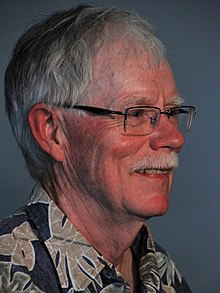| Fred Espenak | |
|---|---|
 Fred Espenak in 2017 Fred Espenak in 2017 | |
| Born | (1953-08-01) August 1, 1953 (age 71) New York City, New York, U.S. |
| Occupation | Astrophysicist |
| Years active | 1978–2009 |
| Spouse | Patricia Totten |
| Website | mreclipse |
Fred Espenak is a retired emeritus American astrophysicist. He worked at the Goddard Space Flight Center. He is best known for his work on eclipse predictions.
He became interested in astronomy when he was 7–8 years old, and had his first telescope when he was around 9–10 years old. Espenak earned a bachelor's degree in physics from Wagner College, Staten Island, where he worked in the planetarium. His master's degree is from the University of Toledo, based on studies he did at Kitt Peak Observatory of eruptive and flare stars among red dwarfs.

He was employed at Goddard Space Flight Center, where he used infrared spectrometers to measure the atmospheres of planets in the Solar System. He provided NASA's eclipse bulletins starting in 1978. He is the author of several canonical works on eclipse predictions, such as the Fifty Year Canon of Solar Eclipses: 1986–2035 and Fifty Year Canon of Lunar Eclipses: 1986–2035, both of which are standard references on eclipses. The first eclipse he saw was the solar eclipse of March 7, 1970, which sparked his interest in eclipses, and he has since seen over 20 eclipses.
Together with Jean Meeus, he published the Five Millennium Canon of Solar Eclipses in 2006, which covers all types of solar eclipses (partial, total, annular, or hybrid) from 2000 BCE to AD 3000, and the Five Millennium Canon of Lunar Eclipses in 2009, which lists all lunar eclipses (penumbral, partial, or total) in that time span. Later, he published the more compact Thousand Year Canon of Lunar Eclipses 1501 to 2500, the Thousand Year Canon of Solar Eclipses 1501 to 2500, and the 21st Century Canon of Solar Eclipses. He is also a co-author (with Mark Littmann and Ken Willcoxof) of Totality: Eclipses of the Sun.
He was the co-investigator of an atmospheric experiment flown on Space Shuttle Discovery.
He is also known as "Mr. Eclipse." He gives public lectures on eclipses and astrophotography. Astronomical photographs taken by Espenak have been published in National Geographic, Newsweek, Nature, New Scientist, and Ciel et Espace [fr] magazines.
He met Patricia Totten while in India in 1995. They married in 2006.
He retired in 2009. Asteroid 14120 Espenak was named in his honor in 2003.
See also
References
- ^ "NASA's 'Mr. Eclipse' Retires but Still Chasing Shadows". NASA. 20 September 2009. Archived from the original on 22 May 2015. Retrieved 22 March 2015.
- "Bio – Fred Espenak". Archived from the original on 26 June 2022. Retrieved 22 March 2015.
- ^ "TWAN Bio for Fred Espenak". Archived from the original on 18 March 2015. Retrieved 22 March 2015.
- "Five Millennium Canon of Solar Eclipses: -1999 to +3000". Retrieved 17 January 2020.
- "Five Millennium Canon of Lunar Eclipses: -1999 to +3000". Retrieved 17 January 2020.
- "Thousand Year Canon of Lunar Eclipses 1501 to 2500". Retrieved 17 January 2020.
- "Thousand Year Canon of Solar Eclipses 1501 to 2500". Retrieved 17 January 2020.
- "21st Century Canon of Solar Eclipses". Retrieved 17 January 2020.
- "Fred Espenak". Archived from the original on 2 April 2015. Retrieved 22 March 2015.
- "Mr Eclipse". Retrieved 22 March 2015.
- Joyce Lee and Spencer Bakalar, “He Met His True Love While Chasing Eclipses. Now They Chase Them Together”, “Time”, August 17, 2017.
External links
| NASA Goddard Space Flight Center | |||||
|---|---|---|---|---|---|
| Main articles | |||||
| Facilities | |||||
| Notable missions and programs |
| ||||
| People |
| ||||